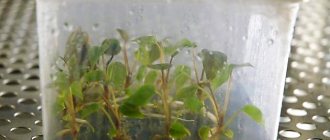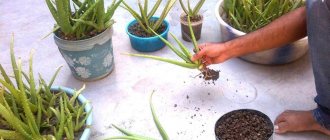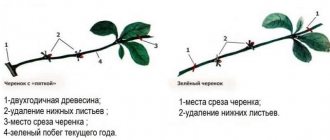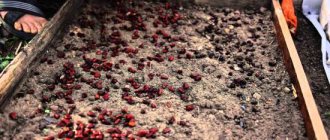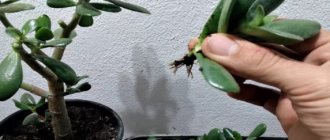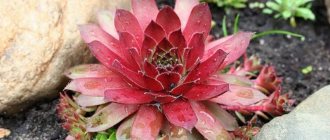Decembrist, also known as Schlumberger's zygocactus, Rozhdestvennik or Varvarina braid, is a forest cactus native to Brazil, growing in the tropics and subtropics. The main feature why many gardeners love it is that its flowers bloom in January.
They replace each other almost all winter and delight the eye with bright colors against the backdrop of white snow outside the window. It is because of its unusual flowering time that it received its name.
There are many options for the shades of this plant, so every housewife will be able to choose a suitable Decembrist for herself.
Most Christmas flowers are white, pink, yellow or orange, but there are also rare shades created thanks to breeders. This plant is well known; it can be found in almost every apartment, but not all flower growers know how to propagate Decembrist correctly. Let's talk about this in more detail.
The plant takes root well and grows if you care for it properly.
There are several ways how the Decembrist flower reproduces:
- Cuttings;
- By segments (air layering);
- Seeds;
- Vaccination;
- Sheets;
- Root parts
There are several conditions that must be met in order to propagate the Christmas tree. This flower loves moisture and sunlight, but does not tolerate drafts, cold and stagnant water.
The soil
It is better to plant Decembrist in a mixture of sand, peat and leaf soil. You can also add crushed charcoal and expanded clay, then mix everything thoroughly to make the soil homogeneous.
This substrate practically does not accumulate moisture and is breathable. Experienced flower growers advise calcining the soil in the oven at 200 degrees for 20 minutes to disinfect it.
A third of the pot should be drainage. Rozhdestvennik does not like stagnant water, since in nature it lives in trees and between stones, where there is practically no soil.
For planting, you can use specialized loose soil for forest cacti or soil for orchids. This plant prefers slightly acidic soil. Therefore, before planting, it is better to do an acidity test using special strips that are sold in gardening stores.
Favorable conditions
Unlike all cacti, the Decembrist does not have thorns, is a moisture-loving plant and does not need abundant lighting. Christmas tree has flattened branches consisting of segments, at the tip of which buds appear. They can have a wide variety of colors: from cream and light pink to dark red. But the most popular are zygocacti with crimson-colored flowers. The root system of the plant is rather weak, but has the ability to quickly recover and form full-fledged roots.
The time for breeding Schlumbergera does not matter; it takes root equally well both in the warm season and in the cold season. Although many gardeners recommend propagating this indoor plant in the second half of February, after the end of the flowering period. During spring formative pruning, the cut parts can also be used to grow new flowers.
The air temperature in the room should be kept at +17–20 degrees. At lower temperatures, cuttings may rot, and in hot weather, they may dry out.
The humidity should not be high, otherwise the petiole will rot.
To avoid this, the prepared shoots are dried on newspaper for 48 hours. During this time, microcracks that arise after unscrewing have time to heal.
Time
The best time to propagate this forest cactus is the end of February. Because the flowering season ends and the season of cactus leaf growth begins.
In spring, the cactus requires formative pruning; the last two or three segments can be used for propagation of the Decembrist.
Humidity
Since this flower belongs to the cactus family, high-concentration humidity can destroy the cutting, simply put, it will rot.
Therefore, the unscrewed cuttings are laid out on newspaper and dried for 2 days.
This time is given for the microcracks that appear on the cuttings to heal when they are unscrewed from the mother plant.
Important! The cuttings are unscrewed clockwise and not cut off. This way the cutting will have less trauma and will be more likely to survive in its new location.
Temperature
The temperature in the room where the Decembrist will breed should be within 17-20 degrees Celsius. Since at a higher temperature the cutting may dry out, and at a lower temperature there will be a likelihood of the cutting rotting.
What soil is suitable for planting?
The soil for planting cuttings should be light and loose. You can purchase ready-made soil intended for cacti or universal peat-based soil at a flower shop. also prepare the soil mixture yourself . To do this you need to mix in equal proportions:
- leaf soil;
- turf land;
- peat;
- river sand.
To improve its structure, add perlite and crushed sphagnum moss to the resulting soil mixture.
The main requirement for the soil is that its acidity should not exceed pH 5.0-6.5.
What is better: making the substrate yourself or buying it in a store?
Both types of substrate are quite suitable for planting zygocactus. The only question is whether the gardener has extra money to purchase a substrate or enough free time necessary to prepare the soil mixture.
The advantages of purchased soil include, first of all, its complete readiness for use, while the substrate mixed by hand still needs to be treated thermally or with fungicides.
But when the mixture is prepared directly for a specific plant, you can choose a ratio of components that will completely satisfy all the needs of a particular flower. Experienced flower growers are of the opinion that it is still better to prepare the substrate at home .
What ready-made mixtures are suitable?
In a specialized store for planting Decembrist, sellers will offer a substrate intended for cacti or a universal one. Despite the fact that the Christmas tree is a cactus, a substrate for succulents that is poor in nutrients is not suitable for it, unlike a universal one. But still, soil for cacti has a number of characteristics that are important for the full development of Schlumbergera:
- looseness;
- air and moisture permeability;
- required level of acidity.
Therefore, professionals recommend mixing the above two types of purchased substrate in a 1:1 ratio .
When choosing a soil, you need to pay attention to the shelf life of the substrate, its composition, physical characteristics: normal level of humidity, fibrousness, the presence of loosening components.
Soil recipe for zygocacti
A caring owner can make a healthy soil mixture himself.
For example:
- Leaf soil, coarse sand, peat and charcoal are mixed in equal parts. You can additionally add turf and humus.
- The next option: 1 part fertile soil, 1 part sand, 2 parts peat. Added perlite and pieces of rotten tree bark will help give it more airiness and looseness.
- Compost soil and river sand are mixed in a 2:1 ratio. Fresh sawdust, activated (or regular carbon), peat, chopped pine needles and sphagnum are added to this mixture.
- Last idea: 1% perlite and vermiculite, 30% vermicompost, 2 layers of drainage and 50% GreenWorld mixture.
This is interesting: Under what conditions do cacti bloom? Serkti for beginner gardeners
What kind of drainage layer is needed under the soil?
The drainage layer is necessary to prevent acidification of the soil and rotting of roots, as it perfectly allows water to pass through and cleanses the soil of toxins and heavy metal salts. Creating a soil drainage system affects the proper growth and health of the flower. This is especially true for the Decembrist, because he is prone to fungal and bacterial diseases.
As drainage you can use:
- pebbles;
- drainage expanded clay;
- gravel;
- crushed sphagnum.
These materials are sold in flower shops; they are completely safe and sterile, as they undergo special treatment against bacteria.
In addition, you can create a drainage system yourself. Suitable for this:
- brick chips;
- crushed stone;
- shards from old clay pots.
You can also use polystyrene foam . It should be crushed to crumbs. Foam chips protect the plant from hypothermia, but do not allow water to pass through well.
Another way to drain the soil is to add loosening additives, hydroabsorbent (vermiculite is added in a ratio of 1:10) and mineral additives (agoperlite).
For the Decembrist, you need to create a drainage layer that occupies one third of the pot. Before laying it, you need to thoroughly rinse and temper the materials used.
Between the drainage layer of crushed stone and expanded clay there must be a layer of sand. If the materials for drainage are small, then they need to be covered with a substrate.
Which container is best to choose for rooting?
Zygocactus has a small and weak root system, especially if we are talking about a very young plant. In addition, after thorough rooting of the cuttings, they need to be transplanted into soil with a more nutritious composition, so rooting does not require a large container . You can use plastic cups or small flowerpots with a volume of approximately 150-200 ml.
There must be drainage holes at the bottom of the container used, and immediately before planting the cuttings, it is necessary to pour a drainage layer into it at least 1/3 of the height, which can be expanded clay, perlite, vermiculite, broken brick or small pebbles.
Dimensions
To plant, you need to take a low, wide pot . In a container that is too deep, the roots do not reach the bottom, so moisture may remain at the bottom of the pot. This causes waterlogging of the substrate and rotting of the root system.
When choosing a pot for replanting, the appropriate size is determined by placing the old pot in a new one. It should go in completely, leaving a little free space between the walls - no more than one centimeter.
An overly spacious pot will lead to active growth of green mass and roots, which will interfere with the flowering of the plant.
Material
Decembrist can be planted in both ceramic and plastic containers . In this case, the characteristics of the selected material should be taken into account. Ceramics are natural and porous.
If it is not covered with glaze, oxygen passes freely to the roots, and excess moisture evaporates through the walls of the pot. This prevents such unpleasant phenomena as rotting of the root system and the development of mold.
The ceramic pot has excellent thermal conductivity . However, in the process of removing a plant from such a container during replanting, the roots that have stuck to the inner walls may be damaged. Another disadvantage of this material is the formation of salt deposits on the surface of the flowerpot, which clog the pores. Getting rid of salts is quite difficult.
Bright and colorful glazed pots have their pores partially closed. Plastic is an artificial material. These flowerpots are easy to clean. The downside is the fact that plastic is not porous, makes it difficult for oxygen to reach the roots and slows down the evaporation of moisture.
Excessively abundant and frequent watering leads to rotting of the roots (you can find out how to properly water the Decembrist so that it blooms luxuriantly and is healthy here). This deficiency can be corrected. It is enough to ensure good drainage when planting and not to allow the soil to become waterlogged.
A container intended for Schlumbergera must have a drainage hole that will allow water to drain freely.
Plastic
Advantages:
- Cheapness.
- A light weight.
- Practicality.
- Durability.
Flaws:
- Instability.
- No pallet.
Standard drainage holes for Decembrist are very small. Therefore, to maintain comfortable growing conditions for the plant, large holes should be made in the pot. This will prevent rotting due to poor air permeability and evaporation of liquid.
Clay
Clay pots look very unusual and original. There is a wide variety of interesting shapes and designs on sale. But this is not the only advantage that clay has. Advantages:
- Good breathability.
- Rapid evaporation of liquid.
Disadvantages: massiveness.
Ceramics
Ceramic pots are also distinguished by their originality, and some advantages of plastic ones. Advantages:
- A light weight.
- Practicality.
- Durability.
Flaws:
- Instability.
- No pallet.
Ceramic pots are more expensive than plastic ones, therefore, when choosing between ceramics and plastic, in the case of the Decembrist, you can give preference to plastic.
By following the above recommendations for choosing soil for Decembrist, you can get a wonderful, unpretentious plant that can reward you with lush and bright flowering.
Time and temperature
Decembrist needs to be propagated after flowering. Otherwise, it may affect his growth and development. Each variety of zygocactus blooms at different times: in November-January, December or March.
The best period for Decembrist breeding is considered to be the end of February. If this time is missed, then cuttings can be taken in the spring or early summer, before the leaf mass grows.
The comfortable temperature for propagation of Zygocactus Schlumbergera is 170-20 degrees Celsius. If the temperature is higher, the cutting will dry out, and if it is lower, it will rot.
Pot
Should be tall and not wide. You can use plastic cups up to 200 g in size. This volume will last the cuttings for a year. There must be holes in the bottom of the container to drain excess water.
Do not take a pot that is too large, as the flower may rot in it. Also, if the Schlumberger roots do not cover the entire volume of soil in the pot, it will not bloom. Therefore, for replanting, take a pot slightly larger than the previous one.
Propagation of Schlumberger by cuttings
The easiest way to propagate a Decembrist flower at home is by cuttings. This method of propagation guarantees that the shade of the flowers of the young Christmas tree will be the same as that of the mother plant.
Choosing a time
It is best to choose cuttings at the end of February or in the spring, after the zygocactus has bloomed. At this time, the season for increasing the leaf mass of Schlumberger usually begins.
Select a cutting and separate it from the plant
We select a cutting and separate it from the plant. Use the outermost cuttings on the shoots, consisting of long leaves. These stems should be free of mechanical damage and have good turgor.
It is desirable that they have aerial roots, which sometimes arise due to high humidity in the room. Cuttings cannot be cut with a knife or scissors, so simply take and unscrew the branch in two or three segments clockwise, holding the mother stem with your other hand so as not to break it. This way the cutting will receive less injury and will survive reproduction more easily.
Landing in the ground
Once you have taken the cutting, simply plant it in the ground. Many gardeners dry it by placing it on newspaper and leaving it in the sun for two to three days. This pause allows the cutting to heal the microcracks that occurred when separated from the mother plant.
Once it has dried, plant it in moist soil. The sprout must be covered with earth to the middle. You can place an upside down jar or plastic bag on top to create a mini greenhouse. Once a day, the jar or bag should be removed for several hours to air.
If the sprout has put out new stems, this means that it has grown roots. Now it can be transplanted into a larger container if required.
Seed propagation at home
Epiphytic Decembrist cactus is a flower that can be propagated using seeds. The process is quite long, young plants bloom only 3 years after sowing. The seed type of propagation is interesting because having several bushes with flowers of different colors, you can get plants with unexpected petal colors.
Seed options
How to propagate an orchid at home
Planting material is sold in flower shops; you can get the seeds yourself using pollination. Zygocactus pollen does not lose its fertile properties for 2-3 weeks, so if the flowering dates of the bushes do not coincide, it can be preserved. Pollen is carefully applied to the corolla with a brush. After some time, ovaries form in place of the flowers. They ripen within 6-8 months.
On a note! The seeds will be mature when the ovary takes on the appearance of a soft pink or purple berry measuring 1-1.5 cm.
Seed preparation
Ripe seeds are cleared of pulp and washed in a 3% solution of hydrogen peroxide or potassium permanganate. Decembrist seeds are shaped like a poppy seed. Dried seeds are stored in linen bags at room temperature and humidity 60-70%. The germination of planting material is maintained for 3-4 years. Before sowing, the seeds are heated for two days at a temperature of 45-60. Then soak for 2 hours, adding growth stimulants to 50 ml of water: 7-10 drops. "Energen" or 1-2 drops. "Epina."
Ripe zygocactus berries
Sowing time
Sowing is carried out in March-April. As a substrate, use universal soil with sand in a 1:1 ratio. The seeds are laid out on the surface of the ground, not buried inside the soil, but only lightly compacted. The planting box is covered with polyethylene or glass.
Seeds germinate in the light. Plantings are ventilated and sprayed daily. The first seedlings emerge in 2-4 weeks. The polyethylene is removed and spraying continues. In the phase of two true leaves, the plant is picked, lightly pinching the roots.
On a note! Young bushes are planted in separate small pots at the age of 2-3 months.
We propagate Decembrist in water
You can place the cuttings in water. Use a container with warm water; it should cover the cutting halfway. If the water has evaporated, add the required amount. If the water turns yellow and thick, it means it has gone bad.
Change it and wash the cutting, then place it in a clean container. After 5-14 days, roots will appear on it. When they become longer than two centimeters, the sprout can be planted in the ground.
Make a hole in the middle of the soil in the pot and place the germinated cutting there. Be sure to water generously, but do not overwater. After this, you can place the pot on a windowsill or other place suitable for zygocactus.
In order for the cutting to grow roots faster, you can use the growth activator Kornevin.
Why does the cutting wither or rot?
If the cutting begins to wither, this means that a fungal infection has appeared in it. Treat it with a fungicide. If, after using the product, the Decembrist continued to wither, it means that its root system died. The cause could be a draft or watering with cold water.
If you water too much, the cuttings may begin to rot. In this case, it must be removed from the ground, cut off the rotting part and dried again for two days. After this, plant it in new soil and water less often than before.
Possible growing problems and methods for solving them
Immediately after transplanting a young Decembrist, some problems with its growth may appear. So, the most common is the wilting of the entire flower. Most often this is due to the development of a disease that could appear at the time the cuttings were separated from the mother plant. This can also be caused by rotting of the root system itself, which often occurs due to excessive watering and improperly selected substrate.
Withering flower
Watering with cold running water and excessive fertilization can cause the stem to become loose. In order to eliminate this problem, it is necessary to remove the plant from the pot, cut off the damaged areas and plant the flower in new soil. If the entire root system dies, cuttings are cut from the flower for propagation.
Flower growers often complain that Decembrist does not bloom. This may be due not only to insufficient care, but also to the onset of a period of rest. This occurs when there is no rest before the buds form. During the dormant period, which lasts from September to the beginning of winter, watering and fertilizing are removed, and the pot is moved to a cool, dark place. At the end of autumn, the pot is again placed in a warm place and all care is gradually restored.
Many gardeners, especially beginners, may be frightened by the sudden fall of Christmas tree leaves due to mite infestation (insecticides are used for treatment). Also, leaves fall off due to the flower being in a draft, sudden changes in temperature, dry air and insufficient fertilizer. In such cases, it is very important to determine the cause of the problem and eliminate it.
Decembrist propagation by segments (air layering)
To take an air layer from the Decembrist, you need to water it abundantly. The next day you can select a few leaves and break them off. You need to take those segments on which small white roots have grown. Thanks to them, the plant takes root faster and takes root better.
After the cuttings are pinched off, they are planted in moist soil and covered with a jar or bag. Once a day you need to remove the greenhouse to ventilate the sprouts. Otherwise they may become moldy or rot.
Reproduction by grafting
Propagation of zygocactus by grafting is used extremely rarely. For the scion you need a Decembrist with three segments.
The upper part of the prickly pear is cleared of its leaf buds, an incision is made in the upper part and a pointed cutting of the Christmas tree is inserted there. It is better to secure the vaccination site with a medical plaster.
Until the cuttings have taken root, the plant should be kept in a room with a temperature of +18 degrees. Do not place the plant in direct sunlight; the light should be diffused. Side shoots of prickly pear that may appear are removed so that the plant does not lose the necessary strength. The fixing bandage can be removed after new leaves appear on the Decembrist plant.
Useful video
From the video you will learn how to transplant a rooted Schlumbergera cutting:
If you find an error, please select a piece of text and press Ctrl+Enter.
Photo from the site: econet.ru
Many people are surprised to discover that there are many things in the world that we could not even imagine, and for novice gardeners, some plants may seem completely mysterious and incomprehensible. For example, can you imagine that there is a cactus that has absolutely no needles, can’t stand direct sunlight, and also quite likes plenty of watering and good fertilizers?
If not, then you are definitely not familiar with the Decembrist, which has the scientific name Schlumbergera, and is also familiar to many under the name zygocactus, which blooms with flowers of unearthly beauty when the rest of the “inhabitants” of the windowsill are in a state of winter dormancy. Our article will discuss exactly how the Decembrist flower reproduces at home, what you need to do to grow such a miracle for yourself, which can delight the eye all winter with bright and unusual inflorescences.
Decembrist propagation by seeds
This method is usually used only by breeders. But if you want to grow your own Decembrist variety with a unique shade, then you will need to propagate the flower from seeds.
Remember that zygocactus is cross-pollinated. That is, at the time of flowering, two or three plants with different shades of flowers will be needed. Do not forget that only pollinated Decembrists will produce seeds.
After flowering, the seeds ripen for six to eight months. They look similar to rose hips. When the berry becomes soft, it is removed and the pulp is removed from the seeds. They are usually planted in the spring.
Preparation
Before planting, it is advisable to wash the seeds in potassium permanganate. After this, spread them on the damp surface of the soil. It is not advisable to sprinkle them with sand or cover them with glass or film.
Seedling care
The first shoots will appear in seven days. Picking is carried out every three months in the first year, then every six months.
Decembrist propagated in this way begins to bloom no earlier than in the third year of life.
Young bushes need to be replanted every spring. The flower tolerates it well and, thanks to it, gets sick less.
Features of the indoor Decembrist
The plant has a short, woody stem and segmented leaves that are made up of elongated parts with wavy or jagged edges, and fleshy, bright green leaves. The flowers are funnel-shaped and can be of different colors. The buds are formed at the ends of the segmented leaves.
The homeland of Decembrist is the southern part of America, where the plant blooms in the summer. At home, hybrids of this species grow, which begin to bloom in mid-December, and if all recommendations are followed, they can bloom twice a year. In addition, every year more and more hybrids with two-color buds appear. The plant itself is quite large and reaches large sizes. In its natural habitat, the flower grows on trees, so its leaves and flowers are directed downward.
Decembrist has three subspecies - Schlumbergera truncated, Gertner and Buckley. The truncated one is distinguished by long segmented leaves, as well as flowers with edges bent outward. The Gertner subspecies has bright orange buds with sharp petals at the ends. Schlumbergera Buckley fascinates with its purple flowers and segments with protrusions at the edges.
Choosing a Good Sheet
Choose fresh, large leaves with good turgor, without scratches or other mechanical damage. It is best to take leaves with roots.
Preparation and planting
Carefully pinch off the leaf, turning it clockwise, and then leave it for two to three days in the shade, placing it on newspaper, so that it dries and heals damage invisible to the eye.
After this, plant the leaf in moist, loose soil half its entire length and cover it with a jar or bag to create a mini-greenhouse.
Before planting in the ground, the leaf can be placed in Kornevin’s solution. When the roots appear, it can be planted in the ground in a permanent place.
In general, propagation of the Decembrist flower by leaf is almost no different from the use of cuttings. This method is the least popular, since cuttings take root better than leaves.
Peculiarities
Reproduction of Decembrist with the help of shoots allows you to get a new plant while preserving all the species characteristics of the mother bush (flower color). The optimal period for cuttings is the beginning of spring. By this time, Schlumbergera has faded and the growing season begins.
Flower growers note that shoots taken in March take root and grow more actively. If the spring period is missed, then you can take propagation material in the summer, during the formation of the bush.
The number of segments on the process does not matter. Cuttings from 1-2 segments and long shoots taken during molding take root. It is not recommended to take more than four segments; such a process is more difficult to work with. When planting in the ground, installation of supports will be required.
Zygocactus cuttings are rooted in two ways:
- in the substrate (soil for forest cacti, universal soil based on peat, perlite);
- in water.
Both options are used equally. The choice depends on personal preference. If you follow the cutting rules, a positive result is guaranteed both in water and in soil.
Propagation by part of the root
This method can be used if the plant is sick or withered, but the root remains intact and unharmed.
To propagate Decembrist with part of the root, you first need to prepare the soil. To do this, mix peat with soil and coarse sand and water it. After this, inspect the root and trim off the damaged areas.
Place the remaining part of the root in a solution of potassium permanganate for half an hour. Then dry it by sprinkling the cut areas with charcoal.
Plant the root in the ground at a shallow depth; after planting, you need to water it and cover it with a jar or bag on top, creating a greenhouse. As soon as new shoots appear, the greenhouse can be removed.
The plant can be replanted into a new pot only after it has grown.
Caring for a young plant
Young shoots need to be cared for in the same way as an adult plant. You can water it only with warm water. If after twenty minutes there is still water in the pan, drain it.
Before watering, it must be left to stand for 24 hours so that all the chlorine and its derivatives have time to disappear. If the air in the room with the Christmas tree is dry, you should also spray the flower with warm water without chlorine. Water the plant only if the top layer of soil is completely dry, otherwise the Decembrist will rot.
Buds that appear on cuttings that do not have roots must be removed so that the plant does not waste the energy necessary for root growth on flowering. Do not move pots with cuttings until rooting is complete, which will end a month after planting. The easiest way to understand that a flower has taken root is by the roots visible from the drainage holes in the bottom of the flowerpot.
It may seem that propagating Decembrist is difficult and time-consuming. But in fact, this flower reproduces very easily and takes root in new soil. By following simple rules for caring for Zygocactus Schlumberger, you will get a lot of emotions watching the plant bloom in the middle of winter.

